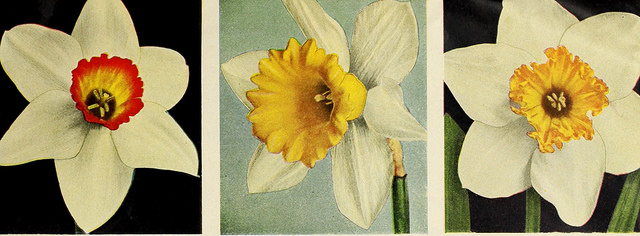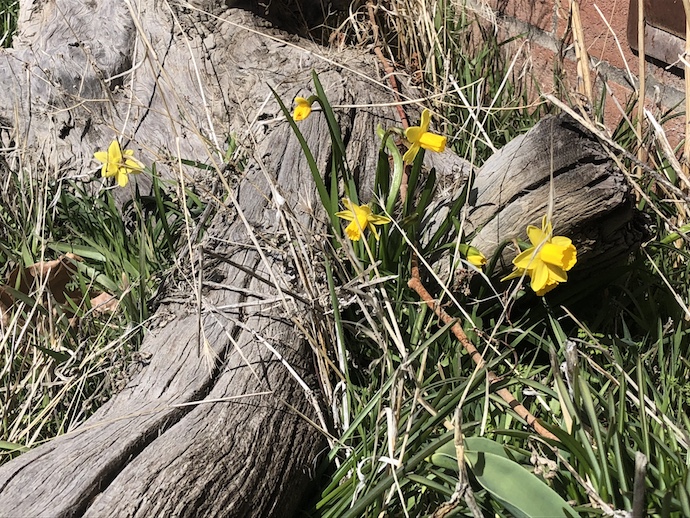
I Wandered Lonely as a Cloud
by William Wordsworth
I wandered lonely as a cloud
That floats on high o’er vales and hills,
When all at once I saw a crowd,
A host, of golden daffodils;
Beside the lake, beneath the trees,
Fluttering and dancing in the breeze.
Continuous as the stars that shine
And twinkle on the milky way,
They stretched in never-ending line
Along the margin of a bay:
Ten thousand saw I at a glance,
Tossing their heads in sprightly dance.
The waves beside them danced; but they
Out-did the sparkling waves in glee:
A poet could not but be gay,
In such a jocund company:
I gazed—and gazed—but little thought
What wealth the show to me had brought:
For oft, when on my couch I lie
In vacant or in pensive mood,
They flash upon that inward eye
Which is the bliss of solitude;
And then my heart with pleasure fills,
And dances with the daffodils.
It is late March and my daffodils have not yet bloomed. But they are so close that the yellow color is radiating through the thin flesh of the buds. (Here in the mountains, my daffodils have resisted becoming antevernals, Michelle’s word for flowers that eerily appear well before their time thanks to a changing climate.)
Around the world, daffodils are a sign of spring. As Noel Kingsbury recounts in his highly recommended treasure-trove of information about common garden plants, Garden Flora, the genus Narcissus spirals out from a center of diversity in Iberia and the Maghreb in Northern Africa and is found in the wild as far away as western Europe and Iran (and now in the Americas, the UK, and Japan). It comprises 70 species and some 27,000 cultivars—all of them suitable for filling one’s heart with pleasure in person or later on when lounging on one’s couch in a vacant or pensive mood. (And if you aren’t doing any phone-less couch lounging these days, check out these tips for returning some salubrious vacancy to your life.)
Daffodils are springlike not only because of the timing of their bloom and their extravagantly cheerful yellows and oranges, but because of their reliability and tenacity. Although the darkest days of winter can breed a superstitious doubt, spring always comes back, and so do the daffodils. As Kingsbury writes, “daffodils reappear faithfully every year, not just in gardens but wherever they may have been dumped decades ago—for these are true clonal perennials.”
You can probably recall seeing daffodils in abandoned or neglected gardens, empty lots, cemeteries, or nodding in the wash of traffic by the side of the road. They can thrive on neglect and abandonment. Kingsbury’s chapter on Narcissus includes a photo of just the kind of “host” of golden daffodils that so nourished Wordsworth’s soul, with the caption, “Feral daffodils in Herefordshire, England.”
Feral daffodils are varieties created or moved by humans that have made a wild life for themselves, like house-cats living in city parks or feral chickens in Hawaii. Feral daffodils prefer a habitat that, like themselves, is neither completely domesticated nor completely wild. Old fashioned hay meadows and grazed woodland are some of their favorite haunts. Thus when farms either intensify their production or completely abandon the land to scrub, daffodils can lose habitat.
This is playing out in Northern Italy, where carpets of native white poet’s daffodils (Narcissus radiiflorus) are recognized as indicators of high diversity hay meadows, ecosystems that have been managed by humans for thousands of years—ecosystems conservationists hope to preserve, in part by mowing them every year in the old way.
I’ve argued elsewhere that we need to intensify agricultural production to create more space for the rest of Earth’s species to thrive. But the non-agricultural area we free up need not be a hands-off wilderness. Replicating older modes of land management may be the best way to support genetic, species, and ecosystem diversity in some places, like those Italian mountain daffodil meadows.

And my vision for what counts as diversity includes both native and feral daffodils. We may have hybridized them or moved them, but their ability to live without us, along with their beauty, entitle them, in my view, to a continued existence. I’m not alone in this belief. In Gloucestershire, UK the wild daffodil (Narcissus pseudonarcissus) is the county flower and is in some places protected, even though everyone know there were no daffodils in Britain until, at the very earliest, the the Roman invasion.
The abandoned house next to mine still hosts daffodils though its human residents have gone. They have actually already bloomed. I just checked. If you look for them, you are sure to find similar feral colonies, or even single plants, tenaciously re-springing each year, happy to mark the seasons without us, blurring the lines between a wild plant and a garden plant, just as we have blurred the lines between a wild planet and gardened planet.